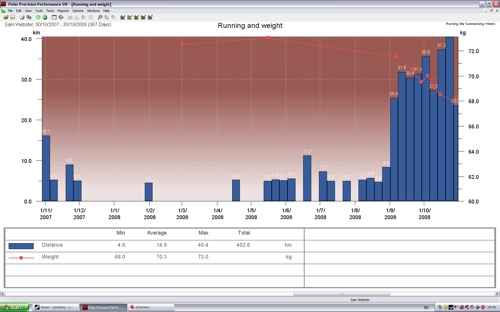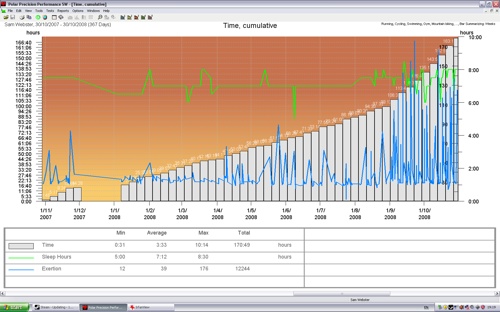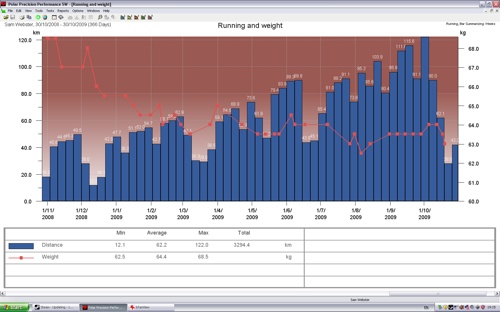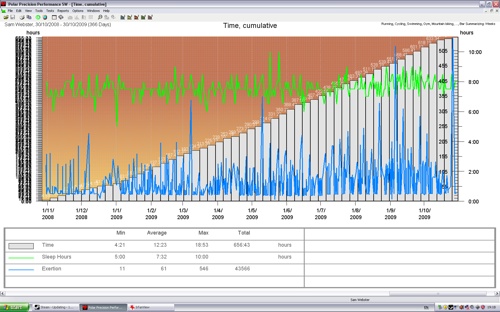I mentioned in my Dublin marathon race report that I’d show some data from the year of training leading up to that race. What do you have to do to run a 2:46 marathon?
Let’s start with the year before I started preparing, i.e. from November 2007 to October 2008. Here’s a graph of all the running I did during that period (the blue bars are km of running per week):

You can see that I started running regularly in September 2008. Before that I was playing a fair bit of golf, cycling to work and running occasionally for fitness’ sake. I logged 403km of running for the whole year, and most of that was done in September and October.
Look at all my training for that same period:

This is a graph accumulating time so hours for each week are added to the grey columns, and I was averaging 3 and a half hours a week of mostly cycling to work with the odd run. I logged a total of 171 hours for that 12 month period, and the increasing steepness of the “curve” towards the end of the year reflects that start to my run training. The gap in December 2007 and part of January occurred just after Annabel was born. She was in the neonatal unit from her birth until Christmas and I spent that entire period with her, Kim and Jack and doing what they needed. I didn’t cycle to work as I was ferrying Kim and Jack around by car, and the neonatal unit is at the hospital by the university. You can also see a drop in sleep hours (green line) between the start and end of that period, but I doubt I recorded much data during that period at all. I was on coffee and Red Bull to try and maintain brain function.
Let’s compare those data with the 12 months leading up to the marathon then:

That’s quite a nice, organised chart. You can see the increasing volume with each week (blue bars are km run per week), with recovery periods every 4 weeks and a few easy weeks in places for mental and physical recovery. I went from running the occasional 5km in 2008 to a big week of 122km, which was actually a total of 143km in 7 days from Sunday to Saturday (I raced a half-marathon in Pembrokeshire on the Sunday and then ran 122km over the next 6 days). I logged 3294km over that 12 month period. The marathon week is at the far right of the chart, and you can see the taper weeks leading to it.
That’s a huge and potentially dangerous increase in running volume, and I was only able to do it with the help of Gareth Davies at the Swansea University Sports Village who looked after my legs. As a sports therapist he picked out my weaknesses and gave me strength training programmes to fix them, and massage to help me repair. With time the long runs got easier and became normal runs, and the long runs got longer. When I started running it was with the thought of running a sub-3 hour marathon, but I still remember finding 7-minute/mile pace really tough and thinking, “26.2 miles of that?!”
I had never competed at half marathon distance before. I don’t think I’d ever run more than 7 miles before.
So I’ve suggested that I was doing more than just running. Let’s look at my training hours for everything (running, cycling, swimming and strength work):

Compared to the previous year that’s a monster chart. It’s another cumulative chart adding hours onto hours. I logged 656 hours of training and averaged 12 hours a week. As I got used to the volume 12 hours became a damned easy week. I’m still training for around 10 hours a week now in the off season when I’m just doing what I feel like. Clearly, early in the season I was still getting used to training and running again, and as the volume increased I began to average 15 hour weeks later in the season. The blue line is a measure of exertion (taken from heart rate data) and the peaks indicate races or particularly hard training sessions. If you look closely at each week block you can often see a small peak mid-week (tempo run) and a taller peak at the end of the week (long run). The biggest peak of them all at the end of the chart is the marathon.
There’s a big difference between the 2 12-month periods. I think I’m probably on for a 650-hour year for this calendar year, and with the swap towards cycling I’ll probably have a 700-hour year next year. That’s about as much as I can fit in at the moment (with some serious time management).
So what does it take to run a 2:46 marathon? Well, it took me around 650 hours of training, with almost 3300km (2063miles) of running, 2 hours a week in the gym, 5 hours a week on the bike and a couple of swims a week for a year. Volume did wonderful things to my legs but without the other work to strengthen my legs and core I wouldn’t have managed it.
There are far too many important factors in all of this to list, but being aware of my fatigue and recovery was crucial to me this year. Also, following training plans from the Runner’s World Smart Coach pushed me and showed me that I was capable of more than I would have expected. Reading as much as I could also helped me understand what I was doing. Joe Friel and Peak Performance have always been awesome sources of information. Inevitably however, much of training and racing is finding out what works best for you. And that’s part of the fun.